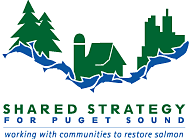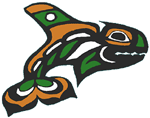|
Catching Fewer Fish to Give Them a Chance Certain images from Kit Rawson’s years of working in front of the Tulalip Marina stick with him. “I see, right before my eyes, fishing knowledge being passed down through generations -- grandfathers and fathers teaching the next generation how to fish,” says Rawson, senior fisheries management biologist with the Tulalip Tribes and member of the Puget Sound Technical Recovery Team. To promote responsible and sustainable fisheries for generations, the Tulalips have cut back significantly on their fish take over the last few decades. “Our harvest management strategy is working,” said Joe Hatch, Fisheries Manager with the Tulalip Tribes. “Great sacrifices have been made by our fishing communities, but those sacrifices are starting to pay off.” Harvest Management As Part of a Broader Strategy The results can be seen in record and near-record salmon “escapement” -- the number of fish allowed to spawn in order to sustain a run at a desired level -- over the last few years. The tribal and state co-managers establish escapement goals to ensure healthy fish populations in the future. In 2001, they achieved the highest Chinook escapement in the Snohomish basin in nearly 40 years. In 2002, about 7,200 Chinook in the Snohomish river system -- including the Snohomish, Skykomish and Snoqualmie rivers - escaped to spawn. This exceeded the former goal of 5,250, and marked the fourth time in the past five years that the co-managers were able to exceed this level. Plus, more than 155,000 Snohomish chum moved upstream, shattering the minimum escapement number of 28,000 and representing the highest observed Snohomish chum numbers in over 20 years. “The higher escapements we’ve achieved in recent years show that we’ve really decreased harvest pressure. We’ve set the bar very high in that regard,” said Rawson. “More than ever, I’m convinced that setting the bar high is the way to go.” The co-managers know that just limiting harvest isn’t enough, though. That’s why the Snohomish watershed recovery plan, now being developed under Shared Strategy for Puget Sound as a template for future efforts, combines sound harvest management with habitat and hatchery reform goals. Testing the Habitat The Tulalip Tribes are working together with county and local governments on a comprehensive and ambitious set of agendas. This slate of policies includes harvest restrictions that are carefully targeted and scientifically sound. The needs of wild salmon are very simple and straightforward: cool, clean water to swim in; gravel to build nests and lay eggs; undisturbed shorelines; a river system with minimal pollution. Providing these things, though, is the most difficult environmental, economic, political and social challenge the region faces. Lost and degraded habitat conditions put a ceiling on the amount of fish any river system will produce, no matter how many salmon escape to spawn. Tulalip’s harvest restrictions are designed to test the habitat in the region, to see how much natural production it can support. By putting more fish into Snohomish basin spawning grounds, the plan is to maximize the number of salmon in the river system. “A fallacy that many people fall into assumes that the more we cut back fishing, the more stocks will recover. But harvest is just a piece of a larger picture,” said Rawson. “To go to zero fishing wouldn’t get us any further toward recovery.” That’s because allowing more fish to spawn into degraded habitat doesn’t necessarily mean salmon runs will grow. Increased salmon production requires habitat recovery and restoration. But while that crucial work is taking place, how are the tribes balancing the need for harvest with the need for plentiful wild fish in the river? That’s where hatcheries come in. The Tulalip Tribes’ Bernie Kai Kai Gobin Salmon Hatchery uses the latest science to produce fish for harvest, easing the pressure on wild runs. Time and place restrictions make Tulalip Bay one of the few places tribal and non-tribal fishermen can catch a chinook salmon – without worrying about harming the threatened wild run. “It’s important for everyone, Indian and non-Indian, to continue to have harvest opportunities while we rebuild salmon stocks,” said Rawson. “Rebuilding is going to take a long time, so we have to ensure that people don’t lose their traditional fishing knowledge.” Sharing Information Just as knowledge is power for fishermen, information is essential for fisheries managers. Factors essential to fisheries management constantly change. Ocean conditions, flooding, drought, and other natural forces make salmon runs fluctuate. The realities of harvest and habitat require an open mind and a keen ear for the latest science. Particularly in Snohomish County, where the watershed recovery plan being developed now will lay the groundwork for future efforts, gathering as much knowledge as possible will be pivotal. That, says Rawson, is the vision that animates Tulalip fisheries staff – and where the Shared Strategy comes in. “Any time, any place, we’re willing to sit down and talk about our harvest management strategy,” said Rawson. “The Shared Strategy framework is a source of hope. When everybody talks and shares information, everybody learns. If we’re serious about achieving salmon recovery, this is the way to do it.” Contact: Kit Rawson at krawson@tulaliptribes-nsn.gov |
||||||||||||||||||||||

